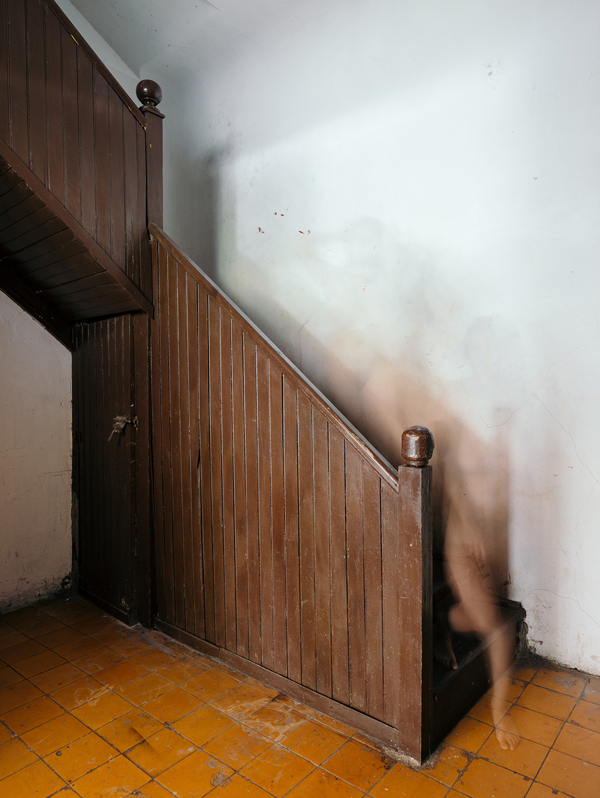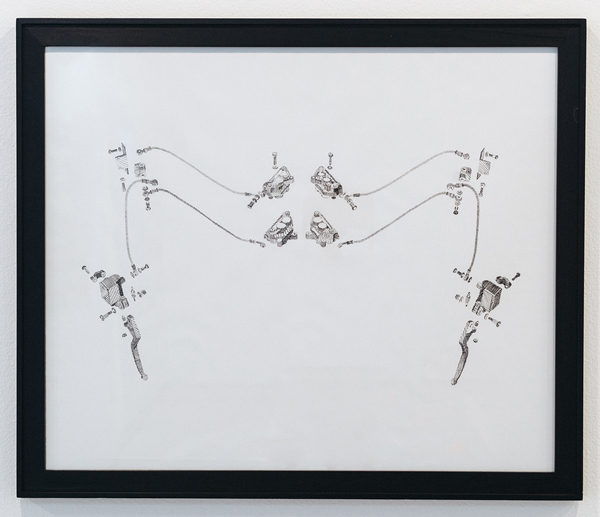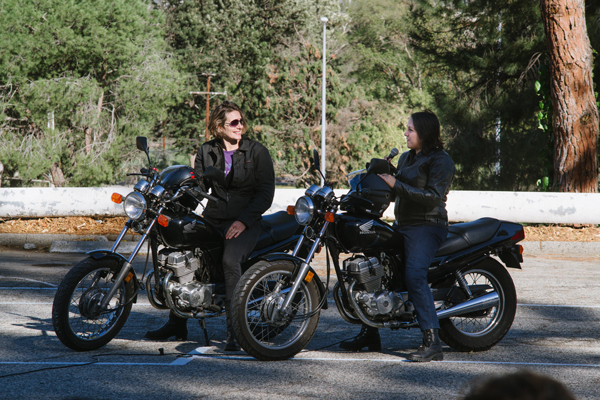When Carmen Argote was 17, her father took off for Guadalajara, Mexico, back to his hometown and his dream of living in a house he had designed for himself and his family. However, his wife felt quite settled in Los Angeles—their two children had grown up here, her own mother was here. He ended up leaving on his own, riding away on his prized Moto Guzzi V11 EV motorcycle. It was a painful split, and for the past decade Argote has been exploring aspects of home and memory through a series of art projects. Most recently, during a residency at 18th Street Arts Center, she completed two parts of “If it were only that easy” in which she revisited her father’s fascination with motorcycles, how she has been learning to ride one, and the journey she plans to take.

720 Sq. Ft.: Household Mutations, 2010, carpet from artist’s childhood home, house paint, Los Angeles County Museum of Art, 2017.
This rainy afternoon her studio is crammed with old work and work-in-progress—she’s preparing for the Hammer Museum’s upcoming “Made in L.A.” (June 3–Sept. 2) biennial. A large canvas being stretched is in one corner, next to one of her older ceramic works—she majored in ceramics at UCLA, studying under noted artists Adrian Saxe and Phyllis Green. A large, semi-circular wooden form, somewhat like an igloo, occupies the center of the room; a fabricator is on his way over to work it into something Argote has in mind. We move a couple of chairs to sit by her computer and look at her previous work.

Se metió pol la azotea, 2016, digital C-Print, photo courtesy of Shulamit Nazarian Gallery
Argote was five when her family moved to Los Angeles from Mexico. She grew up in the Pico-Union neighborhood, and later attended Santa Monica College. “I enrolled in a painting class,” she says, “and I remember thinking to myself, ‘Oh, this is actually something I could see myself doing for the rest of my life.’ I have to say that at the time I had no idea what that meant because although my family has always been artistic, nobody had gone to college for art.” Later she transferred to UCLA, where she got a BA and then an MFA, completed in 2007.
In 2010 she began using art to explore—perhaps to better understand—events in her life. At her computer she pulls up photographs of an apartment interior, emptied of furniture. “This is my childhood home, the apartment I grew up in, part of my grandmother’s quadruplex,” she explains. She borrowed the apartment for an art installation, painting the interior with a fresh coat of white. That included the wall-to-wall rug, except for a border with its stains left in original brown. For a month the apartment was open to visitors—Argote admits with a smile that many were just interested in seeing the inside of the flat. Later, the rug was taken up and presented as an art piece, 720 Sq. Ft. Shape Seeps Through at the Vincent Price Art Museum (2013), and then at LACMA during the “Home—So Different, So Appealing” exhibition last year. (It was subsequently purchased by LACMA, to Argote’s delight and relief— she was getting tired of storing it.) At LACMA one end of the scroll of rug hung from the wall, while the corridor section spilled downward into the “kitchen” and “living room.” For her it was important that the piece could “fluctuate between art history and personal history.”

Legs. Motorcycle Foundations 1, 2018, ink on vellum, courtesy Commonwealth and Council
In 2014 she continued her exploration of personal history by going to Guadalajara and setting up a residency at the colonial-style Mansión Magnolia, a house that had been in her family for some time and is now run as a public events space. She spent three months there, and two years later, returned for another three weeks, recreating the room in which she was staying by hanging muslin from the walls and painting objects in the room onto the muslin. Later she took a series of photographs in the various spaces, some of them with herself in apparitional form since she would move during long exposures. Some of these are currently on view in “Extracorporeal (Beyond the Body),” a group show dedicated to Ana Mendieta at the Museum of Latin American Art, through July 29th. The idea Argote says, was that “by inhabiting a place and by spending an extended period of time there, I would get to know it.”

If only it were that easy, performance, 2018, photo of Carmen Argote with Nancy Popp, photo by Craig Kirk.
On January 20, as part of PST LA/LA, Argote presented the first part of her “If it were only that easy” project—a performance/training session in a Griffith Park parking lot. She invited seven other creatives who ride motorcycles, including Nancy Popp and Bill Kelley, Jr., to teach her the tricks of navigating a heavy vehicle. Argote rode with them, one at a time, and wove around a course marked by small red cones and lines. A walkie-talkie system in their helmets allowed them to talk to each other, a conversation bystanders could hear via loudspeakers. The subsequent 18th Street exhibition showed a video of the performance, plus a real live motorcycle (Argote’s own) at the entrance. On the floor were different paths delineated by painted chalk, and on the wall were drawings of motorcycle parts. Ultimately, the project will culminate in a motorcycle ride from Los Angeles to Guadalajara, retracing her father’s steps, and then returning. “I really wanted to center the show on my father’s bike being this magical object that has power to heal that moment that he left,” she says, “to heal the years we haven’t been talking.”
Already there has been some healing. She and her father speak by phone—about motorcycles and riding them, naturally.


